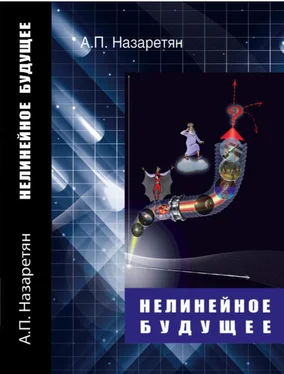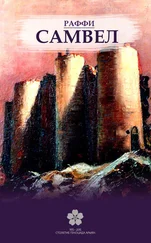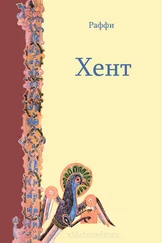Акоп Назаретян - Нелинейное будущее
Здесь есть возможность читать онлайн «Акоп Назаретян - Нелинейное будущее» весь текст электронной книги совершенно бесплатно (целиком полную версию без сокращений). В некоторых случаях можно слушать аудио, скачать через торрент в формате fb2 и присутствует краткое содержание. Жанр: Философия. Описание произведения, (предисловие) а так же отзывы посетителей доступны на портале библиотеки ЛибКат.
- Название:Нелинейное будущее
- Автор:
- Жанр:
- Год:неизвестен
- ISBN:нет данных
- Рейтинг книги:4.33 / 5. Голосов: 3
-
Избранное:Добавить в избранное
- Отзывы:
-
Ваша оценка:
- 80
- 1
- 2
- 3
- 4
- 5
Нелинейное будущее: краткое содержание, описание и аннотация
Предлагаем к чтению аннотацию, описание, краткое содержание или предисловие (зависит от того, что написал сам автор книги «Нелинейное будущее»). Если вы не нашли необходимую информацию о книге — напишите в комментариях, мы постараемся отыскать её.
Нелинейное будущее — читать онлайн бесплатно полную книгу (весь текст) целиком
Ниже представлен текст книги, разбитый по страницам. Система сохранения места последней прочитанной страницы, позволяет с удобством читать онлайн бесплатно книгу «Нелинейное будущее», без необходимости каждый раз заново искать на чём Вы остановились. Поставьте закладку, и сможете в любой момент перейти на страницу, на которой закончили чтение.
Интервал:
Закладка:
Zimmerli W. Who is to blame for data pollution? On individual moral responsibility with technology // Philosophy and technology II. Information technology and computers in theory and practice. Dortrecht etc.: D. Reidel, 1986: 291-305.
A series of independent calculations undertaken by various authors show that nature and then human society have been developing in accordance with general vectors and that this development has been successively accelerating for billions of years: the time between phase transitions in biospheric, pre-social and social evolution have been decreasing in a logarithmic fashion. Having extrapolated the hyperbolic curve, the researchers found that the speed of global transformations will reach infinity and the interval between the phase transitions will reach zero by the middle of the 21st century.
Does this imply that an unprecedented turning point in the development of humanity, the biosphere and perhaps the cosmos is expected in the observable future? What alternative scenarios are there? Is an irreversible collapse or a crucial change of vectors to be expected? How might the prospects of world civilization depend on our thoughts and activities?
In order to discuss this situation, the author uses the scholarship developed by Mega-history (synonymous with Big, or Universal History), along with modern conceptions of astrophysics and microphysics, complexity theory, cultural anthropology, psychology and heuristics. He concludes that after having become a planetary factor, intellectual activity is apt to become a factor of cosmological significance. What might become a decisive obstacle to such development are not the limits of the mind’s ability to control mass and energy but its suicidal inability to cope with its own growing power. The book explores new perspective in worldviews and the meanings of life, which might promote the sustainability of global civilization under rapidly changing conditions.
At the 1st page of the cover you find Alex Pinkin’s picture ‘The two hoses of Mega-History’
At the 4th page – Ivan Maximov’s picture ‘ The stairs of Universal evolution’
Why have social forecasts been so often unsuccessful? Opening remarks ………… 5
Introduction. The 21st century: A nonlinearity gradient ………………………….... 28
Part I. Trends & Mechanisms of Universal Evolution: An Essay on Mega-History………………………………………………………….... 39
Section 1.1. From Olduvai Gorge to Silicon Valley………………………………. 39
Ch.1.1.1. Vectors of social history…………………………………………….. 39
§1.1.1.1. Panhuman history: Realities & ideological representations……….. 40
§1.1.1.2. “Progress” & “happiness”: Are the emotional-evaluation criteria of historical development reliable? ………………………... 56
§1.1.1.3. Three vectors of social evolution: Technology – demography – organization………………………………………………………… 63
§1.1.1.4. The forth vector of evolution: Information & intelligence. “The end of geography”……………………………………………. 69
§1.1.1.5. The fifth vector of evolution: Restrictions in physical violence. Bloodshed Ratio as a cross-cultural index………………………….. 85
§1.1.1.6. The techno-humanitarian balance and the sixth vector of evolution: Virtualization……………………………………………102
Ch.1.1.2. Phase transitions in social history & prehistory…………………..121
§1.1.2.1. “A dove with a hawk’s beak” & the life-asserting neurosis………..122
§1.1.2.2. Cultural pseudo-speciation, selection & crises in the Paleolithic…..136
§1.1.2.3. The Neolithic: At the threshold of society-nature & inter-tribe cooperation………………………………………………………….150
§1.1.2.4. The Urban Revolution: “Habitual” & written law………………….164
§1.1.2.5. “Morals for bronze” & “morals for steel”: The origins of critical thinking……………………………………………………………...176
§1.1.2.6. Prehistory & the formation of “indust-reality”. Disappointments of industrial paradise………………………………………………..195
§1.1.2.7. The Century of Humanism? ………………………………………..211
§1.1.2.8. On the counterfactuals in history: From free will to evolutionary hyperbole……………………………………………………………229
Ch.1.1.3. A Complexity-Theory view of evolution……………………………235
§1.1.3.1. Sustainable non-equilibrium & types of crisis. The Law of delayed dysfunction & the Rule of redundant variety………………236
§1.1.3.2. Evolutionary dynamics: The Law of requisite variety & the Law of hierarchical compensations……………………………..247
§1.1.3.3. Complexity: Structure, energy & information. Intellect as Maxwell’s Demon…………………………………………………..252
Section 1.2. From the Big Bang to the Olduvai…………………………………….265
Ch.1.2.1. Mega-evolution: Planetary & cosmic contexts of human history…………………………………………………......265
§1.2.1.1. The constructs of World, Global & Universal (Big) history………..265
§1.2.1.2. Versions of Universal history……………………………………….271
§1.2.1.3. Universal history, cybernetics & synergetics……………………….277
Ch.1.2.2. Continuity of the evolutionary mechanisms………………………..283
§1.2.2.1. Collisions of sustainable non-equilibrium in the biosphere………...283
§1.2.2.2. Expansion of evolutionary hyperbole, and – again on the counterfactuals……………………………………………………...290
§1.2.2.3. The cosmological arrow of time…………………………………….295
Part II. Humanitarian determinants of the future………………………………...301
Section 2.1. The midst of the 21st century: The Singularity Puzzle……………....301
Ch.2.1.1. “The laws of nature” & creative mind……………………………..301
§2.1.1.1. The Snooks-Panov Vertical. Mind as an agent of universal evolution…302
§2.1.1.2. The two key questions for strategic forecasting……………………306
Ch.2.1.2. The challenges of the 21st century…………………………………..320
§2.1.2.1. What is meant by “Global crisis”? …………………………………320
§2.1.2.2. Humanist culture and human biology………………………………322
§2.1.2.3. “Knowledge-enabled destruction”………………………………….325
§2.1.2.4. Attractors & scenarios………………………………………………329
Section 2.2. The world-vision paradigm for survival……………………………...344
Ch.2.2.1. Ideology vs . civilization?…………………………………………….344
Читать дальшеИнтервал:
Закладка:
Похожие книги на «Нелинейное будущее»
Представляем Вашему вниманию похожие книги на «Нелинейное будущее» списком для выбора. Мы отобрали схожую по названию и смыслу литературу в надежде предоставить читателям больше вариантов отыскать новые, интересные, ещё непрочитанные произведения.
Обсуждение, отзывы о книге «Нелинейное будущее» и просто собственные мнения читателей. Оставьте ваши комментарии, напишите, что Вы думаете о произведении, его смысле или главных героях. Укажите что конкретно понравилось, а что нет, и почему Вы так считаете.










